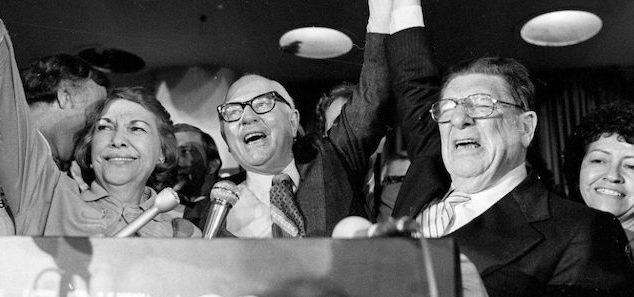Opinion
Gov’s plan: ‘Rebate’ and ‘sharing the wealth’ are deeply misleading
 Paul Gann, center, author of the 1979 initiative governing excess tax revenue, and Howard Jarvis celebrate the passage of Proposition 13. (Photo, June 1978/ AP file)
Paul Gann, center, author of the 1979 initiative governing excess tax revenue, and Howard Jarvis celebrate the passage of Proposition 13. (Photo, June 1978/ AP file)Let’s not confuse Gov. Gavin Newsom’s proposal to provide $12 billion in new stimulus checks with the state’s constitutional mandate to return excess revenues to taxpayers. That seems to be the goal of those who believe taxpayer refunds are a bad idea and are looking for ways to keep a greater part of the newly announced state surplus to spend.
The governor has announced the state sits on a whopping $75 billion surplus, and that’s not even counting an additional $27 billion expected from the federal government under the federal pandemic rescue plan. Newsom has announced he wants to send stimulus checks of $600 to $1,100 to two-thirds of the state’s residents, as determined by their economic qualifications.
Taxpayers who helped create the surplus wanted their money back. Remember, this vote came one year after state Treasurer Jesse Unruh declared the state was sitting on an “obscene surplus.”
Under Article XIIIB of the California Constitution, if taxes exceed a certain prescribed limit, excess revenue must be returned to taxpayers. The newly announced surplus exceeds the spending limit.
The suggestion has been made that sending the stimulus money to two-thirds of the state’s residents, as Newsom proposes, satisfies a good deal of the constitutional spending limit requirement.
The spending limit is often referred to as the Gann Limit after its chief author, Paul Gann, who led the 1979 ballot initiative, Proposition 4, to establish the law. The limit is established by a formula of previous proceeds from taxes adjusted by population and cost of living growth.
But returning money to taxpayers who paid them and providing stimulus checks to lower income and middle-class taxpayers are not one and the same.
Although you wouldn’t know that when listening to the language used by government officials and following some news reports.
The governor called his new stimulus package a “rebate,” making it feel, intentionally or not, that the money is part of meeting the Gann Limit rebate requirement.
The Los Angeles Times editorial page stated unequivocally that in passing the spending limit, “Californians have already made it clear that they want to share the wealth when the state takes in more revenue than it needs.”
Whoa!
The lopsided 3-to-1 vote supporting Proposition 4 was not trumpeting “share the wealth.”
Democratic Gov. Jerry Brown supported the spending limit idea in 1979 and Assembly Speaker Leo McCarthy, another Democrat, even advocated for Proposition 4 in the statewide ballot booklet.
Taxpayers who helped create the surplus wanted their money back. Remember, this vote came one year after state Treasurer Jesse Unruh declared the state was sitting on an “obscene surplus” that had been whittled down in the aftermath of voters passing the property tax-cutting Proposition 13. The current surplus, as announced by the governor, rivals the obscene surplus of four decades ago.
Democratic Gov. Jerry Brown supported the spending limit idea in 1979 and Assembly Speaker Leo McCarthy, another Democrat, even advocated for Proposition 4 in the statewide ballot booklet, writing, “No government should have an unrestricted right to spend the taxpayer’s money. Government should be subject to fiscal discipline no less than the citizens it represents.”
Proposition 4 clearly states that excess revenue be “returned by a revision of tax rates or fee schedules.” The analysis by the Legislative Analyst’s Office accompanying the measure in the statewide ballot booklet emphasized the point that, “state and local governments return to the taxpayers moneys collected.”
Returning money to taxpayers who paid it is not sharing the wealth.
Sending refunds back to taxpayers does not mean, however, that the governor’s stimulus proposal cannot happen. Government has to return excess funds to taxpayers and can also fund a stimulus under our modern-day obscene surplus.
There’s the federal money that is designed to be used to help the post pandemic recovery. In addition, the spending limit excess, calculated at about $16 billion, still leaves plenty of money not required by law to be spent on specific purposes to be used for the stimulus if the governor and legislature choose.
Yet, the argument will be made to count Newsom’s self-styled “rebate” plan against the spending limit obligation.
Lawmakers and certain interests want to count the new stimulus checks against the obligation to send money to taxpayers, thus freeing up additional surplus dollars to spend as they wish. Funding the stimulus and returning excess taxes should be treated as two separate budget items, even if that means less for the big spenders to spend.
—
Editor’s Note: Joel Fox was the co-publisher and editor-in-chief of Fox and Hounds, a political discussion site, and served as president of the Howard Jarvis Taxpayers Association for 13 years. He currently is on the adjunct faculty in the School of Public Policy at Pepperdine University.
Want to see more stories like this? Sign up for The Roundup, the free daily newsletter about California politics from the editors of Capitol Weekly. Stay up to date on the news you need to know.
Sign up below, then look for a confirmation email in your inbox.

Leave a Reply